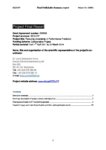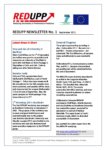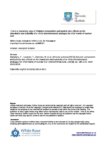REDUPP: Reducing Uncertainty in Performance Prediction
The REDUPP project used laboratory studies to investigate the dissolution of spent nuclear fuel under repository conditions.
Overview
Project Dates: 01/04/2011 – 31/03/2014
Project Status: Finished
Project Website: Not available
In a spent nuclear fuel repository, the engineered barriers are designed to protect humanity from the radiological risks associated with the waste for at least 100 000 years. Water is not expected to enter the canisters for a very long time. However, when it does, the spent nuclear fuel will start to dissolve, resulting in the release of the radioactivity into the surrounding environment. Therefore, the rate with which the spent nuclear fuel dissolves is central to the safety assessment of the spent fuel repository. In the REDUPP project, this question was investigated through dissolution experiments using analogue materials.
Unavoidably, laboratory experiments are of much shorter duration than the time scales considered for safety assessment of the repositories. In order to increase confidence in the extrapolation of these dissolution rates far into the future, a deeper understanding of the dissolution process is required. An interesting and confounding observation, and recognised problem, is that when results from laboratory dissolution experiments are compared with studies of natural systems, the experimental studies indicate dissolution rates that are orders of magnitude higher. This problem was addressed in the REDUPP project by investigating how the surface of a dissolving solid changes during the course of dissolution. It is at the sold-fluid interface that dissolution takes place, and by using modern experimental equipment, very fine details of the changing surface could be imaged and analysed. Coupling analysis of the bulk solution with the studies of the surface, it was possible to identify which sites at the surface were most reactive during the dissolution process. Another issue that was investigated was the effect of using real, natural groundwater instead of the simulated groundwater compositions that were used previously.
The experiments showed that the dissolution slowed down as it proceeded. Dissolution of grain boundaries played an important part in the first few days, resulting in a relatively fast initial rate. As these sites dissolved, the dissolution rate decreased. In addition to these crystallographic effects, the chemical composition of the fluid also affected the dissolution rate, with pH and carbonate content having a significant impact. Changes in the chemical composition of the fluid over time can therefore affect the dissolution rate. Both these parameters need to be carefully considered when conducting laboratory experiments and when applying derived dissolution rates to analyses that cover many thousands of years.
Objective
The overall aim of the REDUPP project was to improve understanding of spent fuel dissolution under repository conditions. Within this aim it had two key objectives:
- Improve the understanding of surface maturation and possible changes in reactivity and dissolution rate over time; and
- investigate the effect of natural groundwater containing trace elements on the chemical reactions involved in the dissolution of aged spent nuclear fuel.
In addition, the project aimed to provide training for young researchers to undertake future research needed to support radioactive waste disposal.






